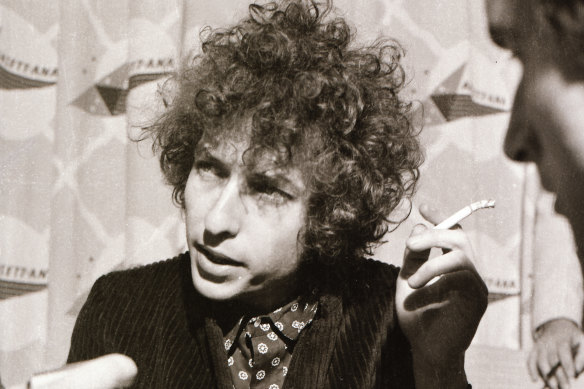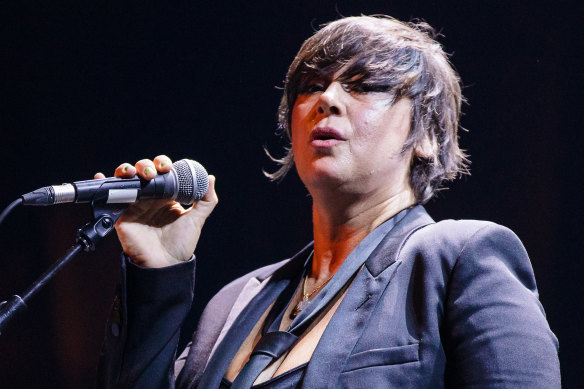
Uproar at Bob Dylan concert,” reads one headline adorning his Live In Sydney 1966 bootleg. “Sydney’s wackiest concert,” reads another, jostling against “Bad Boy Bob!”, the shock revelation that “Dylan brings own group” and the perennial favourite, “Traitor”.
“Oh my god,” Chan Marshall, aka Cat Power, gasps. “It’s like they wanted to beat his ass every night.” His crime, old timers will recall, was in the eyes of the folk/protest establishment he’d left behind: an urge to power his increasingly psychedelic poetry with the ragged might of a rock’n’roll band called the Hawks.
“He did the tour. He wasn’t gonna stop. He was like, ‘I’m doing this shit’,” Marshall says. “And that’s where great art comes from: sticking to your gut and doing exactly what you need to do. Sometimes it’s like that. You think, ‘I don’t know what the f--- I’m doing, but I gotta do it.’”
There was a bit of that in November 2022, confesses Marshall, in her bold decision to re-record Dylan’s infamous 1966 set live at London’s Royal Albert Hall. Today she’s resting in Woodstock, where Dylan too took refuge after that world tour, in the midst of her own world tour that will bring her 1966 Royal Albert Hall Concert to Australia in March.

Bob Dylan in Melbourne during his 1966 tour. Credit: Fairfax Media
Former Melbourne journalist and record retailer David Pepperell recalls “it was like hearing rock and roll music for the first time”. He heard a few boos early in the electric half, but the folkies soon retreated.
He vividly remembers a more confrontational audience in Sydney, though
another eyewitness, Clif Lang, father of guitarist Jeff Lang, recalls only adulation for the 23-year-old prophet in the dark shades, orange-and-brown houndstooth suit and Cuban heels. “I went there a fan,” he says. “I left a fanatic.”
It was ever thus with the man Marshall calls God Dylan. Facts and myth blur into some collective dream state, as if every acolyte must get stoned on the tangled mysteries of his songs, disappearing through the smoke rings of our minds, down the foggy ruins of time and so on without end.
“Growing up,” says Marshall, “there was delight in not knowing exactly verbatim what Bob was saying in those songs. There was this kind of inner dialogue that we had to have… and it’s pretty powerful stuff, you know; this silent, secret mystery. A lot of people used to talk about what this stuff meant.
“But most people don’t sing these songs every day for a year,” she adds with a laugh. “In doing that, five nights a week, whatever, there’s been some revelations that are like, ‘Damn, I had no idea that that f---in’ means this!’ There’s been a lot of that ... in the past few months.”

Cat Power on stage in May. “Doing something like this, it’s like baking a loaf of perfect bread,” she says of the Dylan tour.Credit: Getty Images
Nailing specifics is a fool’s game in Bob-lore. Marshall’s loose-associating revelations touch instead on timeless conundrums of “being a woman, being a mother, Palestine, all the terrible things happening in America again; the environment… and religion and power and the military complex and the same f---ing capitalist-fascist bullshit that’s more disgustingly in our faces than ever before.”
External strife aside, Dylan was on a dizzying inward voyage as a writer leading up to the tour that would be his last for eight years. The album Highway 61 Revisited had just yielded the rich panorama of Desolation Row, the contemptuous Ballad of A Thin Man and Like a Rolling Stone, three songs he’s still unpacking in concert.
Ironically, the enhanced surrealism of his then-unreleased masterpiece, Blonde On Blonde, mostly occupied the acoustic half of the show, before the electrical storm that would, by the time it reached England, sometimes lead crowds to heckle and explode.
First without and then with her own band, Cat Power faithfully retraces each step on her album but obviously with far less calamity, and a great deal more clarity and timbral beauty than the battle-pitch required of Dylan and his besieged musicians (soon after rechristened The Band).
“That’s exactly the point,” Marshall says. “That was a moment ... in history that he lived, and I know from my own experience of the road what a struggle that is, how hard that is. Now I want these songs, for him, to rest in a tranquil place, like a garden.”
Renowned as an interpreter of rare authority as well as a songwriter, the Atlanta-born singer’s empathy with Dylan’s struggle is acute. Facing an audience “has always been a confrontation for me,” she says.
Loading
“It wasn’t fun for me for the first 15, 20 years. But it was the only place that I had real psycho-spiritual freedom in my life. It’s the only place where I felt like I had some personal, private portal that a few people would come along for the ride, and that made us stronger together.
“It took me years to realise… there’s some sort of vibration that we all meet on, and it does something to me every night, because I try to crawl out of this waking time structure and into this format where the art lives and where the soul lives, and where we all are bound, or boundless, in our alone place together.
“I try to move into some strange dimension where we can all just exist without shame or self. And because it’s Bob Dylan, the intention is stronger. There’s more attention on me when I’m playing these shows, because half of the people there don’t actually know my music. They know Bob Dylan, and they love him.”
True as that is, Cat Power’s ardour has an aura all its own. Asked which song in the set she’s most besotted with today, she flirts with It’s All Over Now Baby Blue and Desolation Row before deciding.
“Mr. Tambourine Man, I think, is the most beautiful. It gives me the most hope. That song has the vulnerability of, like, ‘I’m giving up. Man, take me up on that spaceship. I’m out. I can’t cope. Let me f---ing believe and hope for one minute; just a glimmer’. That one is the saddest and the most illuminating one; the most innocent.
Loading
“Ultimately, I think people are drawn to Bob because they feel that melancholy of being alone. They need to feel understood. They need somebody to explain the better path, or the conflict in a more poetic way, so they feel better in their day.”
On the day we speak, Bob Dylan’s Neverending Tour bus is cruising just a few hours southeast of Woodstock between Maryland and Cincinnati. It’s not impossible to imagine him dropping by to share his notes on Just Like A Woman or Leopard-Skin Pillbox Hat. But it’s neither here nor there to Cat Power.
“Doing something like this, it’s like baking a loaf of perfect bread,” she says. “It’s like creating the perfect meal for someone you’ve loved since you were a little kid. It’s like building a dollhouse, where they can fit and their feet can go up, and you can wash their hair, you can pick some herbs and create their tea.
“That’s what this record feels like for me. I haven’t asked for feedback, because it doesn’t matter. You know, when you love somebody and you send them a bouquet of flowers, you don’t ask if they like them. You just continue to love them.”
Cat Power Sings Dylan: The 1966 Royal Albert Hall Concert is at Festival Hall, Melbourne, on March 6, with special guest Buck Meek. Other Australian dates will be announced on October 1; lovepolice.com.au



























